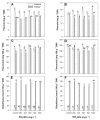Silicon Nanoparticles Improve the Shelf Life and Antioxidant Status of Lilium
- PMID: 34834701
- PMCID: PMC8624484
- DOI: 10.3390/plants10112338
Silicon Nanoparticles Improve the Shelf Life and Antioxidant Status of Lilium
Abstract
The production of ornamentals is an economic activity of great interest, particularly the production of Lilium. This plant is very attractive for its color and shapes; however, the quality of its flower and its shelf life can decrease very fast. Therefore, it is of the utmost importance to develop techniques that allow for increasing both flower quality and shelf life. Nanotechnology has allowed for the use of various materials with unique characteristics. These materials can induce a series of positive responses in plants, among which the production of antioxidant compounds stands out. The objective of this study was to determine the impact of the application of silicone nanoparticles (SiO2 NPs) on the quality, shelf life, and antioxidant status of Lilium. For this, different concentrations of SiO2 NPs (0, 200, 400, 600, 800, and 1000 mg L-1) were applied in two ways, foliar and soil, as two independent experiments. The contents of enzymatic (superoxide dismutase, glutathione peroxidase, catalase, ascorbate peroxidase, and phenylalanine ammonia lyase) and non-enzymatic (phenols, flavonoids, and glutathione) antioxidant compounds, the mineral content, flower quality, and shelf life were analyzed. The results showed that the application of SiO2 NPs through the foliar method induced a greater flowers' shelf life (up to 21.62% more than the control); greater contents of Mg, P, and S (up to 25.6%, 69.1%, and 113.9%, respectively, compared to the control); more photosynthetic pigment (up to 65.17% of total chlorophyll); more glutathione peroxidase activity (up to 69.9%); more phenols (up to 25.93%); and greater antioxidant capacity as evaluated by the DPPH method (up to 5.18%). The use of SiO2 NPs in the production of Lilium is a good alternative method to increase flower quality and shelf life.
Keywords: enzymatic and non-enzymatic antioxidants; flower quality; nanotechnology; ornamentals.
Conflict of interest statement
The authors declare no conflict of interest.
Figures






Similar articles
-
Impact of Selenium and Copper Nanoparticles on Yield, Antioxidant System, and Fruit Quality of Tomato Plants.Plants (Basel). 2019 Sep 20;8(10):355. doi: 10.3390/plants8100355. Plants (Basel). 2019. PMID: 31546997 Free PMC article.
-
Synergistic Effects of Kaolin and Silicon Nanoparticles for Ameliorating Deficit Irrigation Stress in Maize Plants by Upregulating Antioxidant Defense Systems.Plants (Basel). 2023 Jun 5;12(11):2221. doi: 10.3390/plants12112221. Plants (Basel). 2023. PMID: 37299200 Free PMC article.
-
Biochemical and phytochemical responses of Ammi visnaga L. (Apiaceae) callus culture elicited by SiO2 and graphene Oxide-SiO2 nanoparticles.Plant Physiol Biochem. 2023 Jul;200:107741. doi: 10.1016/j.plaphy.2023.107741. Epub 2023 May 10. Plant Physiol Biochem. 2023. PMID: 37192582
-
Responses of Tomato Plants under Saline Stress to Foliar Application of Copper Nanoparticles.Plants (Basel). 2019 Jun 4;8(6):151. doi: 10.3390/plants8060151. Plants (Basel). 2019. PMID: 31167436 Free PMC article.
-
The Application of Selenium and Copper Nanoparticles Modifies the Biochemical Responses of Tomato Plants under Stress by Alternaria solani.Int J Mol Sci. 2019 Apr 20;20(8):1950. doi: 10.3390/ijms20081950. Int J Mol Sci. 2019. PMID: 31010052 Free PMC article.
Cited by
-
Nanoparticles as a Tool for Alleviating Plant Stress: Mechanisms, Implications, and Challenges.Plants (Basel). 2024 May 31;13(11):1528. doi: 10.3390/plants13111528. Plants (Basel). 2024. PMID: 38891334 Free PMC article. Review.
-
Pre and postharvest characteristics of Dahlia pinnata var. pinnata, cav. As affected by SiO2 and CaCO3 nanoparticles under two different planting dates.Heliyon. 2023 Jun 14;9(6):e17292. doi: 10.1016/j.heliyon.2023.e17292. eCollection 2023 Jun. Heliyon. 2023. PMID: 37441372 Free PMC article.
-
Silicon Nanoparticle-Induced Regulation of Carbohydrate Metabolism, Photosynthesis, and ROS Homeostasis in Solanum lycopersicum Subjected to Salinity Stress.ACS Omega. 2022 Sep 5;7(36):31834-31844. doi: 10.1021/acsomega.2c02586. eCollection 2022 Sep 13. ACS Omega. 2022. PMID: 36120047 Free PMC article.
-
ZnO nanoparticles as potential fertilizer and biostimulant for lettuce.Heliyon. 2023 Jan 6;9(1):e12787. doi: 10.1016/j.heliyon.2022.e12787. eCollection 2023 Jan. Heliyon. 2023. PMID: 36647345 Free PMC article.
-
Supplementation of silicon oxide nanoparticles mitigates the damaging effects of arsenic stress on photosynthesis, antioxidant mechanism and nitrogen metabolism in Brassica juncea.Sci Rep. 2025 Jul 1;15(1):21476. doi: 10.1038/s41598-025-04553-9. Sci Rep. 2025. PMID: 40595861 Free PMC article.
References
-
- Naing A.H., Kim C.K. Application of nano-silver particles to control the postharvest biology of cut flowers: A review. Sci. Hortic. 2020;270:109463. doi: 10.1016/j.scienta.2020.109463. - DOI
LinkOut - more resources
Full Text Sources

